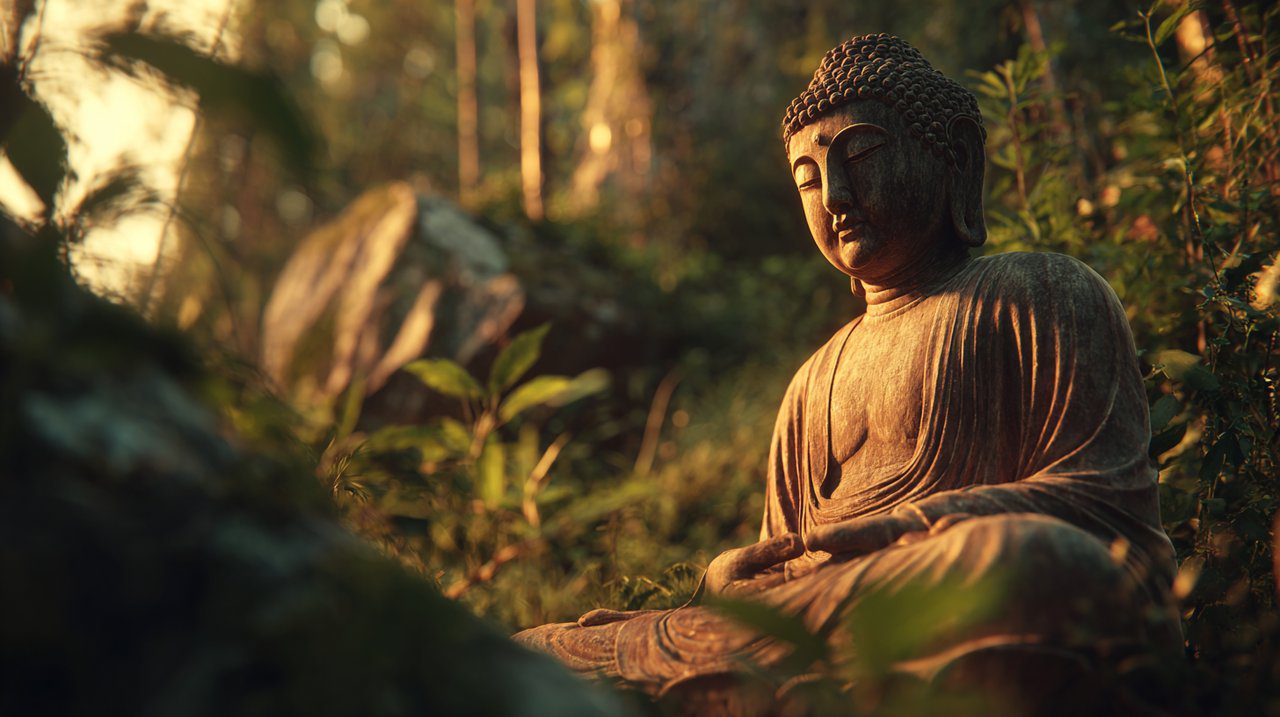The Human Path: Five Insights into the Buddha’s Enduring Legacy
For years, the image of the Buddha felt like a beautifully crafted enigma. I’d gaze at serene statues and read ancient texts, yet a respectful distance always remained. It was as if profound wisdom was locked behind a gilded gate, perpetually just out of reach.
The gate only truly began to creak open when I allowed myself a simple, almost childlike inquiry: “Who was this person, really? Beyond the legends and the reverence?” This shift was pivotal.
The true power of any profound teaching, I’ve found, isn’t in its mystique. Instead, it lies in its unwavering ability to meet us exactly where we are, offering a clear mirror to our own inherent potential. This transformed my view of the Buddha from a distant deity into a relatable pathfinder—a remarkable human being who illuminated a deeply practical way for all of us. This journey of discovery has been profoundly personal, and I’m eager to share the core insights that have truly anchored my own understanding, delving deeper into the very foundations of Buddhist thought and practice Buddhism: Origins, Core Teachings, and Practices Explained.

The Man, Not a Deity
My earliest encounters with Buddhist art often depicted a serene, almost divine figure, perpetually seated in lotus. For years, I subconsciously placed the Buddha on a pedestal, seeing him as some benevolent god or supernatural entity. This is a common perception, but it fundamentally misses the point.
The moment of profound realization arrived when I truly grasped this fundamental truth: Siddhartha Gautama was a human being, through and through. He was born into a royal family, yes, but he navigated life’s joys and sorrows, its heartaches and triumphs, just like you and I. He wasn’t born enlightened; he sought it, painstakingly, through diligent effort and profound introspection.
Think of it like a mountain climber scaling a peak, one deliberate step at a time. This wasn’t magic; it was a journey of focused human endeavor. This realization, for me, was nothing short of liberating, peeling away layers of untouchable divinity.
It replaced them with a tangible, deeply relatable aspiration. If a human being, through dedicated practice and profound insight, could awaken to such a deep understanding of reality, then surely that same boundless potential resides within each of us. It shifted the focus from bowing to an external power to recognizing an immense inner capacity.
I often revisit this insight, especially when my own mind feels like a tangled mess of complexity. It serves as a potent reminder: the path to clarity isn’t reserved for the extraordinary or the perfect. It’s wide open for the persistent—for anyone willing to simply look deeply, with an open heart and a curious mind. We don’t need to be flawless; we just need to be willing to begin.
With the figure of the Buddha now firmly grounded in human reality, we can move beyond the myth and into the very heart of his teachings. What lay at the core of his groundbreaking insights? A clear-eyed, compassionate look at the nature of our own suffering.
The Core of Suffering and Its Cessation
I vividly recall a chapter in my life where, despite everything on the surface appearing ‘perfect’—a good job, loving relationships, comfortable surroundings—I was plagued by a persistent, gnawing sense of dissatisfaction. It wasn’t overt misery, but a subtle, unshakeable unease, like a tiny pebble perpetually stuck in my shoe.
This subtle disquiet reminded me of a client who, despite building a magnificent home, found himself constantly agitated by a barely noticeable, persistent hum from the ventilation system. Outwardly, the house was a dream, but that tiny, unaddressed hum eroded his peace, making him restless even in his own sanctuary.
It was during this period that I truly began to grapple with the profound clarity of the Buddha’s Four Noble Truths. This wasn’t some abstract philosophy; it felt like a shockingly precise diagnosis of my own internal landscape: the truth of suffering (Dukkha), its origin, its cessation, and the path leading to that cessation. It’s a journey into understanding and overcoming suffering that truly transforms How to Understand the Buddha’s Four Noble Truths: A Guide to Overcoming Suffering and Achieving Liberation.
Here’s where many, myself included initially, tend to misunderstand Dukkha. It’s so much more than just physical pain or obvious sorrow. Consider this scenario: you’ve finally landed that dream job, bought the perfect house, or found the ideal partner. For a moment, you feel complete. But then, almost imperceptibly, a new desire arises, a subtle worry creeps in, or the initial glow begins to fade.
This is the inherent ‘slippery’ nature of happiness, the subtle unease that comes with impermanence—the feeling that ‘something is missing’ even when, by all accounts, everything is perfectly present. It’s like trying to hold water in your hands; no matter how tightly you grasp, it inevitably slips away.
I’ve discovered immense transformative power in using these truths as a practical lens for daily living. When I find myself feeling agitated, restless, or simply out of sync, I consciously pause and ask myself a series of questions. This isn’t about wallowing in negativity, but about clear-eyed recognition, which, surprisingly, becomes the very first step toward genuine freedom:
- What is this feeling? (This points to the suffering, the Dukkha, without judgment.)
- What thoughts or attachments are fueling it? (This helps uncover the origin, the root cause.)
- What would it genuinely feel like to simply let this go? (This guides me towards the cessation, the release.)
- What small, intentional step can I take right now to move towards that release? (This illuminates the path, making it actionable.)
This process, for me, is less about finding answers and more about cultivating a deeper awareness. It’s a continuous internal dialogue that keeps me grounded in the present moment and focused on what truly matters.
Once we truly grasp the fundamental nature of suffering and its roots, the next logical question arises: How do we actually move beyond it? The Buddha, ever the pragmatist, didn’t leave us hanging. He laid out a remarkably comprehensive, yet flexible, roadmap for liberation: the Eightfold Path.
The Practical Path to Liberation
When I first encountered the Buddha’s Eightfold Path, my initial reaction was one of immense relief. It didn’t feel like a rigid, dogmatic set of rules to be blindly followed, but rather a remarkably comprehensive and adaptable guide for living. It’s presented as Right Understanding, Right Thought, Right Speech, Right Action, Right Livelihood, Right Effort, Right Mindfulness, and Right Concentration.
For me, it’s nothing less than a profound blueprint for cultivating a life deeply aligned with wisdom, compassion, and genuine well-being, far removed from any sense of restrictive commandments. I’ve come to understand these eight facets not as separate, isolated steps to be checked off a list, but as interconnected threads weaving together the rich tapestry of a truly awakened way of being.
Think of it like a finely tuned orchestra: each instrument (each ‘Right’ aspect) plays a crucial role, but the true harmony emerges only when they play together, complementing and enhancing one another. For example, Right Speech isn’t just about avoiding harsh words; it’s intricately connected to Right Thought and Right Understanding. If my thoughts are rooted in compassion and clarity, my speech naturally flows from that wellspring.
Here’s how I’ve integrated a couple of these ‘threads’ into the fabric of my own daily existence. It’s a continuous process of refinement, much like tending a garden:
- Right Livelihood: This constantly prompts me to reflect on my work. Am I engaged in activities that genuinely align with my deepest values? Am I contributing positively to the world, or inadvertently causing harm to myself or others? It’s not about grand gestures, but about seeking meaningful contribution, however small. I once considered a lucrative opportunity that, upon closer inspection, involved practices I couldn’t ethically endorse. Choosing to walk away, despite the financial appeal, felt like a profound act of Right Livelihood, preserving my inner peace over fleeting gain.
- Right Mindfulness: For me, this is the daily anchor, the quiet practice that grounds everything else. Whether I’m simply drinking a cup of tea, washing dishes, or walking through a bustling street, I consciously strive to bring my full, undivided attention to the present moment. It’s not about emptying the mind, as many assume, but about being fully present with ‘what is’—noticing the subtle shifts in my breath, the warmth of the mug, the sound of distant traffic. It’s like shining a spotlight on the ordinary, revealing its extraordinary depth.
This path, I’ve found, is less about rigid adherence to rules and more about cultivating a conscious, intentional, and deeply compassionate way of navigating the complexities of our world. It’s a living practice, not a static doctrine.
With these practical tools in hand, the question then naturally arises: What’s the ultimate aim? Is this journey reserved for a select few, or is there a universal invitation to this profound awakening that the Buddha spoke of?
Enlightenment’s Universal Invitation
Perhaps one of the most liberating and profoundly reassuring insights that has anchored my understanding is this: enlightenment is emphatically not an exclusive club. It is not reserved only for cloistered monastics meditating in remote, inaccessible monasteries. The Buddha’s teachings consistently, unequivocally, declare that the boundless potential for awakening resides within every single being.
Think of it like a dormant seed waiting for the right conditions to sprout. It’s not about painstakingly transforming yourself into someone else. Instead, it’s about fully realizing and uncovering the luminous truth of who you already are, stripped bare of the layers of conditioning, societal expectations, and illusion that often obscure our innate wisdom.

I recall a particularly quiet morning in my garden, bathed in the soft glow of the rising sun. I watched, captivated, as a tiny dewdrop clung precariously to a vibrant green leaf, shimmering with a thousand facets of light. For a fleeting, exquisite moment, all my worries—the endless to-do lists, the subtle anxieties about the future—simply dissolved.
There was only the dewdrop, the leaf, and an overwhelming, profound sense of interconnectedness and peace. It wasn’t ‘enlightenment’ in the grand, textbook sense, but it was a vivid, unmistakable taste of the pristine clarity and serene presence that is always, always available, just beneath the surface of our busy, often turbulent minds. It was a whisper of what’s possible.
“Just as a spider’s web is woven from its own body, so too is the mind the source of all phenomena.”
This ancient wisdom, often attributed to Buddhist thought, resonates deeply within my core. It powerfully articulates the idea that our experience of reality, our joys and our sorrows, are largely constructs of our own minds. And if our minds are the source of our experience, then the extraordinary potential to transcend suffering and experience profound clarity also resides right there, within us.
It is, unequivocally, an open invitation—not a guarded destination for a chosen few, but a boundless possibility for all who choose to look within. So, if enlightenment is this universal invitation, how do we approach these teachings without falling back into old patterns of blind belief or rigid doctrine? This brings us to a crucial distinction that has shaped my entire approach.
A Way of Seeing, Not Just Believing
For many, and certainly for my younger self, Buddhism is neatly categorized as just another religion, complete with its own rituals, deities, and dogmas. However, my understanding has profoundly evolved. I now perceive it less as a rigid belief system and far more as a vibrant philosophy, a rigorous science of the mind, and an eminently practical way of life.
It doesn’t demand blind faith; instead, it actively encourages deep personal investigation, much like a scientist in a lab. The Buddha himself, with remarkable foresight, urged his followers to test his teachings rigorously, to never accept them simply because he had uttered them. ‘Come and see for yourselves,’ he essentially proclaimed.
Here’s how I’ve chosen to approach these profound teachings. I don’t identify as a ‘Buddhist’ in the traditional religious sense, yet the core principles—compassion, mindfulness, and the unflinching investigation of suffering—are now deeply, inextricably woven into the very fabric of my daily existence. I treat the teachings not as sacred doctrines to be revered from afar, but as a series of hypotheses to be tested, real-time, in the dynamic laboratory of my own lived experience.
Does cultivating loving-kindness genuinely reduce the friction of my own anger? Does consistently observing my breath bring me a greater, more sustainable sense of calm amidst chaos? These are not rhetorical questions; they are living experiments. This investigative spirit, I believe, is precisely what makes the Buddha’s legacy so enduringly relevant, even millennia later.
It’s a radical empowerment. It encourages each of us to become our own ultimate authority, to discover truth for ourselves, from the inside out, rather than passively relying on external dogma or inherited beliefs. It’s about cultivating a discerning mind—a mind that is perpetually asking, ceaselessly exploring, and always, always returning to the raw, unfiltered data of direct experience. This is the true path to wisdom, not just belief.
My deepest hope is that these reflections have offered you a fresh, more intimate lens through which to view the Buddha. No longer a distant, almost mythical figure as he once was for me, but rather a remarkably wise guide whose profound personal journey illuminates a clear, accessible path for our own.
Perhaps, like me, you’ll discover that the most impactful ‘facts’ about the Buddha aren’t neatly cataloged in history books or enshrined in ancient texts. Instead, they are found in the quiet, often surprising moments of your own self-inquiry, when his timeless wisdom resonates directly with the deepest chambers of your inner world.
If any of these shared insights have stirred even a flicker of curiosity within you, I offer a simple, yet profoundly powerful invitation: Take just one minute today. Wherever you are, simply observe your breath. Notice its gentle rhythm, its subtle rise and fall. It’s a small, almost imperceptible step, yet it is a direct, tangible connection to the present moment—a practice that lies at the very heart of the Buddha’s most liberating teachings.
And just as my client eventually found peace by addressing that subtle hum in his magnificent home, so too can we find profound serenity by gently attending to the persistent disquiet within ourselves, transforming our inner landscape into a truly fortified sanctuary.
💡 Frequently Asked Questions
No, the author emphasizes that Siddhartha Gautama was a human being who achieved enlightenment through diligent effort and introspection, not by being born enlightened or as a supernatural entity.
The core of his teachings is the Four Noble Truths, which provide a clear diagnosis of suffering (Dukkha), its origin, its cessation, and the practical path leading to its end.
Dukkha is more than just physical pain; it includes a subtle, persistent sense of dissatisfaction, unease, and the inherent impermanent or 'slippery' nature of happiness, even when external conditions seem perfect.
The Eightfold Path is described as a comprehensive and adaptable guide for cultivating a life aligned with wisdom, compassion, and well-being, rather than a rigid set of rules. Its eight facets are interconnected threads for an awakened way of being.
No, the Buddha's teachings consistently state that the boundless potential for awakening resides within every single being. It's a universal invitation to realize one's innate wisdom, not an exclusive club.







